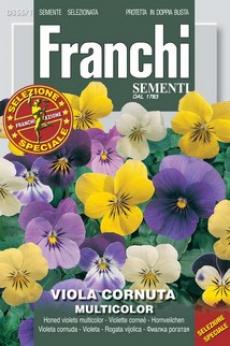
Viola Cornuta, Baby Faces, Tufted Pansy
Viola Cornuta (also called tufted pansy, and Baby Faces) is a very cute little flower that blooms all winter long producing very charming small flowers in jewel-like shades of scarlet, yellow, apricot, blue, violet and white. Long-spurred, light violet flowers open over a long period in spring and early summer on vigorous cushions of lance-shaped leaves. Making superb naturalising specimens, these flowers are pollinated while they are open unlike many other violas species, which are self-fertilised without the flowers opening. It will withstand heat and cold better than ordinary Pansies. Ideal when used for edging or grown in planters and hanging baskets. Use flowers for petite bouquets; Plants are enchanting on slopes and rock gardens. Keep soil moist and remove faded flowers to prolong bloom.
Some additional information from our friends at the North Carolina State Extension Garden:
- Native to the Pyrenees, this popular viola with a light fragrance is often used as a bedding plant. They spread by creeping, ascending stems to 12” wide. They are typically grown as perennials, however, can also be grown as biennials or annuals.
- Blooming in the spring make this a great companion plant for tulips.
- It is a hermaphrodite plant (having both male and female organs) and is pollinated by insects.
- Blooms are typically two-toned, with blue, violet and lavender being the typical colors.
- Extended period of hot weather can bring on a decline in flowering. Cut the plants back to create the possibility of another bloom when temperatures decline. Deadheading can also trigger new buds to appear.
- The young leaves and flower buds are edible both raw or cooked. Tea can be made from the foliage.
- Pansy flowers can be distinguished from violets by examining the petals. Pansies have four petals facing up and one facing down while Viola Cornuta has 2 petals facing upwards and three facing downwards.
- They grow best in humusy, moist, well-drained soils in full sun to part shade. They tend to bloom during cooler weather and stop during the heat of summer. There are many cultivars that extend the color palette.
- Growing in a bed may require weeding until the plants become more established. Once that occurs, they will be an effective cover that weeds may find difficult to penetrate.
- Insects, Diseases, and Other Plant Problems: Snails and slugs may affect this plant as well as fungal leaf diseases.
